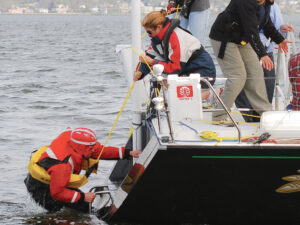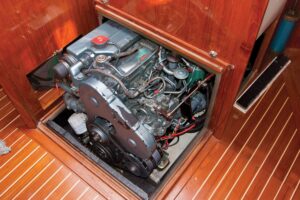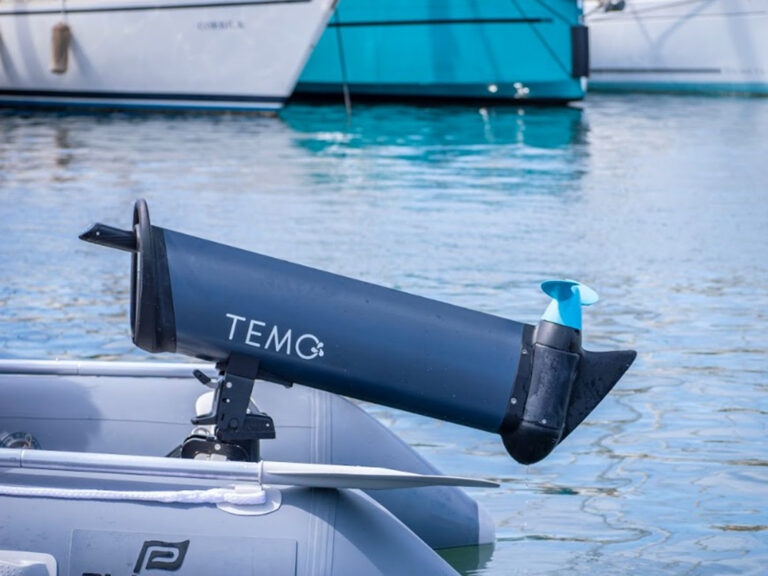The longevity and robustness of the diesel engine is well-known. Unfortunately, most sail auxiliaries never get the opportunity to wear out–they die of neglect and lack of essential, yet usually minor, service. In the three previous articles in this series (“The Ghost in Your Machine,” June 2001; “The Sensible Fuel System,” July 2001; “Can Your Cooling System Take the Heat?,” September 2001) weve looked at the marine diesel engine and its essential systems. In this final installment, well go through routine inspection and maintenance procedures to ensure your engine lives up to its potential.
Keeping the engine, engine compartment, bilge, and fuel tank (inside and out) clean and dry should be high on your list of priorities.
A clean engine and engineering space will enable you to identify and locate leaks and problems quickly. A light-colored engine–as some manufacturers now offer–is a great aid when tracing leak trails.
If any insulation material is crumbling and shedding, it’s likely that it’s being sucked into the engine’s air intake, where it can clog the air filter or cause more serious problems on engines not equipped with air filters. White, fire-retardant, vinyl-faced foam resists deterioration, reflects light well (making for a bright engine compartment), and is easily cleaned.
Cleanliness will facilitate the next most important maintenance procedure: inspections. The engine and engine compartment should be thoroughly inspected, before every start-up.
The Big Check
Routine inspection before you start the engine should include checking the dipstick for the correct quantity of lube oil. If it registers too low or too high, there’s a problem. Low levels could be caused by leaking oil or oil being burned by your engine. Some loss may be normal if the rate you’re losing oil is consistent; a pint every 50 hours, for example, can be expected of engines that are long in the tooth. A faster rate can be indicative of more serious problems. Oil that appears higher on the dipstick (unless added by the operator) can be caused by seawater or coolant leaks into the crankcase. Common sources of these leaks are the oil cooler, exhaust system, or head gasket. Raw water mixed with lube oil will resemble mayonnaise. Coolant and oil will look more brownish, like old varnish. However, if allowed to sit undisturbed long enough, the water and oil will separate, with the oil on top. If this is the case, you can confirm this by draining a sample of oil from the bottom of the pan, from the drain hose, if equipped, or by inserting a small tube into the dipstick fitting. If water comes out before oil, pressure testing and further diagnosis by a mechanic will be required to trace the source. If you suspect water in the engine oil, it’s better not to start the engine, which will only redistribute this mess through the bearings and oil galleries.
The other cause of a high dipstick reading is fuel in the oil. Some injector pumps, which are actually mounted in the engine block, can leak fuel internally, into the crankcase, without giving any clues. If the level is high and the lube oil on the stick feels thinner than normal, or if it smells vaguely like diesel, then fuel is the culprit. Eventually, this thin fuel/oil mixture wont properly lubricate the internal components, wear will accelerate, and the engine could ultimately overheat and/or seize.
You should routinely inspect the sea strainer for blockages. If you suspect theres a blockage, shut the seacock, remove the lid of the strainer, remove the basket, empty it, and, before replacing it, momentarily open the seacock. A surge of water should come out of the opened strainer if the strainer is mounted below the waterline. This will confirm water flow through the seacock and may flush out any growth or debris stuck in the line. If your engine isnt raw-water cooled, check the coolant level in the expansion tank.
Move on to the belts and pulleys. Some marine-engine manufacturers have taken a cue from the automotive industry and are switching to serpentine belts. Equipped with automatic tensioners, these dont require adjustment, only periodic inspection for cracks and tension. The rest of us have to contend with the ubiquitous V-belt. Check belt tension while the engine is off by applying moderate pressure with your finger on a point on the belt thats farthest from the pulleys. Deflection should be roughly 1/2 inch for each foot of belt between pulleys; for a new belt with less than one hour of service, it should be 3/8 inch. If the groove of the pulley and the corresponding belt surface are highly polished, and sometimes even tinted blue, then the belt is slipping. Belt dust on the front of the engine is another clue that the belt is slipping. To prevent slippage, remove the belt, sand the shiny area of all the pulleys with 200-grit sandpaper, install a new belt, properly tension it, then retension it after a few hours of running time.
Finally, the routine engine-compartment inspection should include a look at the fuel filter. Most engines have only one filter that can be visually inspected. This is the primary filter, and its the first one the fuel passes through after leaving the tank. It should be equipped with a clear sight bowl, which will allow you to check for water or dirt. Drain any water if necessary. A vacuum gauge will allow you to check for healthy fuel flow once the engine is running and tip you off if a filter needs replacement before it reaches the recommended replacement interval.
Finally, make a mental note of how the engine sounds, feels, looks, and smells (oil, fuel, and coolant all have distinctive smells when vaporizing on a hot engine) when its running properly. Then youll be cued if somethings not right. Pay attention to warning signs, both subtle and obvious. Excessive steam in the exhaust, for instance, is a sure sign that the volume of cooling water is below normal.
Vital Fluids
When it comes to lubrication, not all oils are created equal. Diesel engines, unlike their gasoline brethren, place special demands on lube oil. Most cruisers have noticed how quickly diesel oil turns black. The amount of ash, soot, water vapor, and acid present in the diesel-engine crankcase demands a specifically formulated oil to contend with these contaminants. Carry out oil changes with religious regularity. Most manufacturers recommend 100-hour change intervals, but you should shorten this on an engine regularly running under light loads, such as when charging batteries or running refrigeration compressors. Check the American Petroleum Institute (API) rating, which should be stamped on the oil container. Diesel-rated oils–designated by a C prefix, such as CF or CG, which denotes “compression” ignition–are carefully formulated with these requirements in mind. The second letter indicates the sophistication of the additive package, and the later this letter appears in the alphabet, the more advanced it is. For instance, a CC- or CD-rated oil would be less desirable than a CE or CG rating.
Diesel-combustion byproducts include sulfuric acid, which is harmful to polished metal surfaces and bearings. The damage is accelerated by running the engine under light loads (cold running) for charging or refrigeration. Cold running creates more soot, which is caused by incomplete combustion. This causes still more problems, such as clogged rings and valve-stem deposits. Prevention is simple: Change the oil and filter regularly, and use the best-quality brand-name oil with the highest C rating you can find.
Fuelish Behavior
As we saw in my previous article in this series (“The Sensible Fuel System,” July 2001), the low tolerances required by the injection system leave it particularly vulnerable to contamination.
Fuel contamination takes several forms, including asphalt, microorganisms, water, and rust. Asphalt is a mineral contaminant found in poor-quality diesel fuels. When found on a filter element, it looks like tar and will dissolve if you spray it with a solvent like WD-40. Biological growth, on the other hand, is the result of microorganisms propagating in the tank. Filters clogged with this material will turn white when sprayed with cleansers containing bleach. These fuel bugs live at the boundary layer between fuel and water, and they need both, as well as warm temperatures, to live. Fuel additives exterminate these critters; however, they should be used sparingly, and only when conditions warrant, such as when cruising in warm climates.
The primary defense against organic contamination is to pump only high-quality fuel, free of water and bugs. Often this is easier said than done. The cetane rating of diesel fuel, roughly akin to gasolines octane rating, can be a benchmark. The higher the cetane rating, the better. Many engine manufacturers now call for a minimum of 45. Beware: Some fuel docks and service stations pump 40, 42, and even 35 (usually indicated by a decal on the pump face). Given no better choice, I would use 40 to 42 cetane, but never 35. Another line of defense against taking on poor-quality fuel is sampling. Using a clear quart or gallon container, preferably glass, pump a sample of fuel, and allow it to sit for a few minutes. It should be free of particles and water, which will settle on the bottom. Good-quality fuel should be translucent and look like weak tea or honey. If it looks like coffee, steer clear.
Even seemingly pure fuel can contain contaminants, however. Another protective measure is to use one of the filtering funnels available at chandlers and hardware stores. These range in price and sophistication, but generally, all will be effective in catching some coarse particles.
Once your fuel is contaminated, the culprit may lurk in the tank, waiting for the right conditions to rear its ugly head. Usually, a boisterous sail is enough to stir up a troublesome soupy mix that works its way into your fuel system.
The best prevention is taking on the cleanest fuel possible, checking and changing filters, and inspecting the inside of the tank. You should be able to clean and inspect every inside surface of the tank through its inspection port. Fuel-tank cleaning services can sometimes improve a situation, but the results are difficult to confirm. Theres no substitute for mechanically scooping out the crud. And if youre in a far-flung port–or worse, at sea–a fuel-cleaning service is of little use.
Cool Running
Number Two on the hit parade of diesel foils is the cooling system. In his article on cooling systems (“Can Your Cooling System Take the Heat?,” September 2001), Ed Sherman covered several key maintenance points, so I’ll only review a few additional trouble spots. Some boats equipped with external strainers, sometimes called “South Bay” strainers, require that the strainer screen be removed. My personal preference is to rely entirely on an internal strainer; it’s easier to service, and you don’t have to get wet to do it. However, some cruising areas have large amounts of weed, grass, or kelp that’s best thwarted by an external screen.
Antisiphon valves, while rarely the cause of overheating, can, when not serviced, flood an engine with seawater (which can seize it) and even sink a boat. The culprit is a small, rubber valve that probably costs less than a buck to manufacture. Check and replace this piece if it’s not operating properly. Incidentally, many antisiphon-valve manufacturers recommend that the unit itself be mounted a minimum height above the waterline (usually 2 feet) at all angles of heel. Actual installations often don’t meet this criterion, especially where the antisiphon valve is mounted to the hull. The preferred mounting location is near the centerline.
The final stop for raw water is the injection elbow and the exhaust system. Clogged injection elbows are a frequent source of overheating. All raw cooling water must exit through this fitting, so it’s easy to see why a clog here can easily cause the entire cooling system to run off the rails. Clogs and restrictions (usually rust and corrosion) slow down the flow of water, reducing the volume, which leads to gradual overheating.
Smoke Signals
One of the best ways to determine if a diesel is running properly is by observing the smoke it produces. Nearly all diesels, even the best running ones, produce some smoke. However, when smoke becomes pervasive, it’s abnormal. For instance, diesels should turn at maximum-rated rpm under load without the governor kicking in and without belching smoke. Test this by letting the engine warm up, then running the engine at full throttle while in neutral. If the engine is rated at 3,600 rpm with a wide-open throttle (WOT), then it should stop at 3,800 or so. If it doesn’t, back off and call a diesel mechanic. The governor, which helps regulate and maintain rpm as engine loads change, isn’t working.
Next, while under way and in gear, accelerate to maximum rpm again. The engine should turn up to within 100 rpm of the WOT rating–3,500 to 3,600 rpm, in this case. If it turns up to only 3,000 rpm and is belching black smoke, theres a problem afoot. The prop could be overpitched or fouled. Black smoke here indicates too much fuel and not enough combustion.
Black smoke is caused by partially burned fuel, although it can have several other contributing causes, including a restricted air filter, misadjusted injection-pump timing, low compression, a malfunctioning turbocharger, and dirty/sticking injectors. White smoke usually indicates misfiring cylinders, poor fuel grade (low cetane) or leaking injectors. (White smoke may also be caused by faulty injection timing on engines with extremely high engine hours or if someone has altered it.) Blue smoke, on the other hand, points to lube oil being burned during combustion. This may be caused by leaking valve seals, worn rings/cylinders, or overcooling. In either case, youll want a mechanics opinion.
Other troubleshooting techniques include isolating problems that affect all cylinders versus those that affect just one or two. An overadvanced injection pump will cause all cylinders to clatter, while a faulty injector will affect only one cylinder. An injector with a stuck nozzle valve will cause loud banging as fuel fills the combustion chamber at the wrong time, resulting in pre-ignition. Individual cylinders can be taken offline to isolate problems. Cranking the engine with a suspect injector removed but still attached to the high-pressure fuel supply will allow you to check the injectors spray pattern. Warning: Keep well clear of the fuel stream when doing this: Pressurized fuel can penetrate the skin. Wear safety goggles. If theres any doubt as to what the pattern should look like, substitute one of your new spares.
Bearing noises can be located using an inexpensive stethoscope. Many mechanics still prefer the age-old broomstick method, holding one end to the ear and the other against various parts of the block while the engine is running. If the extraneous noise from an accessory is complicating the search, temporarily remove its belt and proceed. Dont run an engine for more than a minute or so with a disconnected circulator-pump belt; never run one with a disconnected raw-water-pump belt.
Some of the techniques described above require practice and experience, but they may be beneficial when cruising far from expert help.
Steve DAntonio, a Cruising World contributing editor, manages Zimmerman Marine in Cardinal, Virginia.








